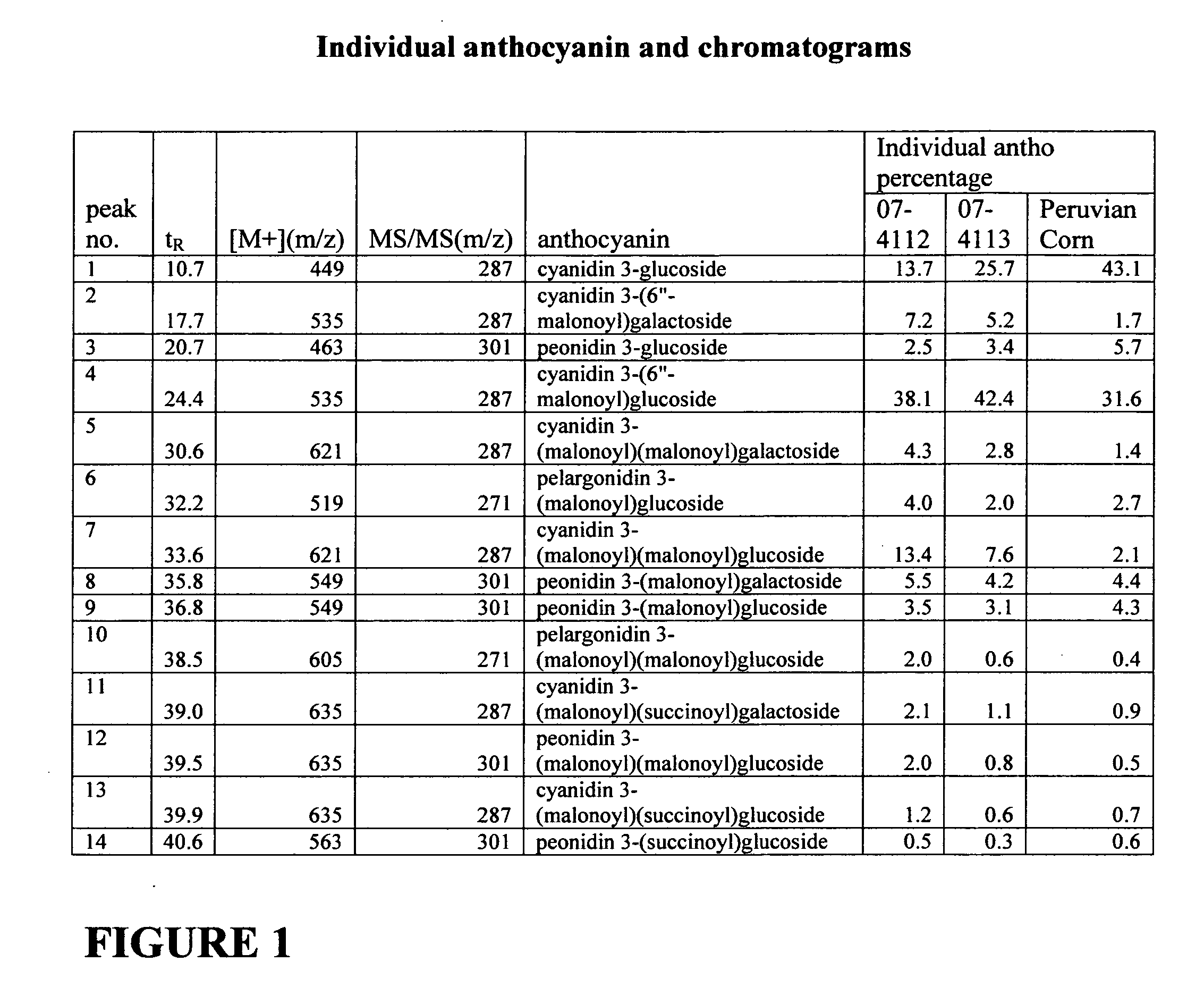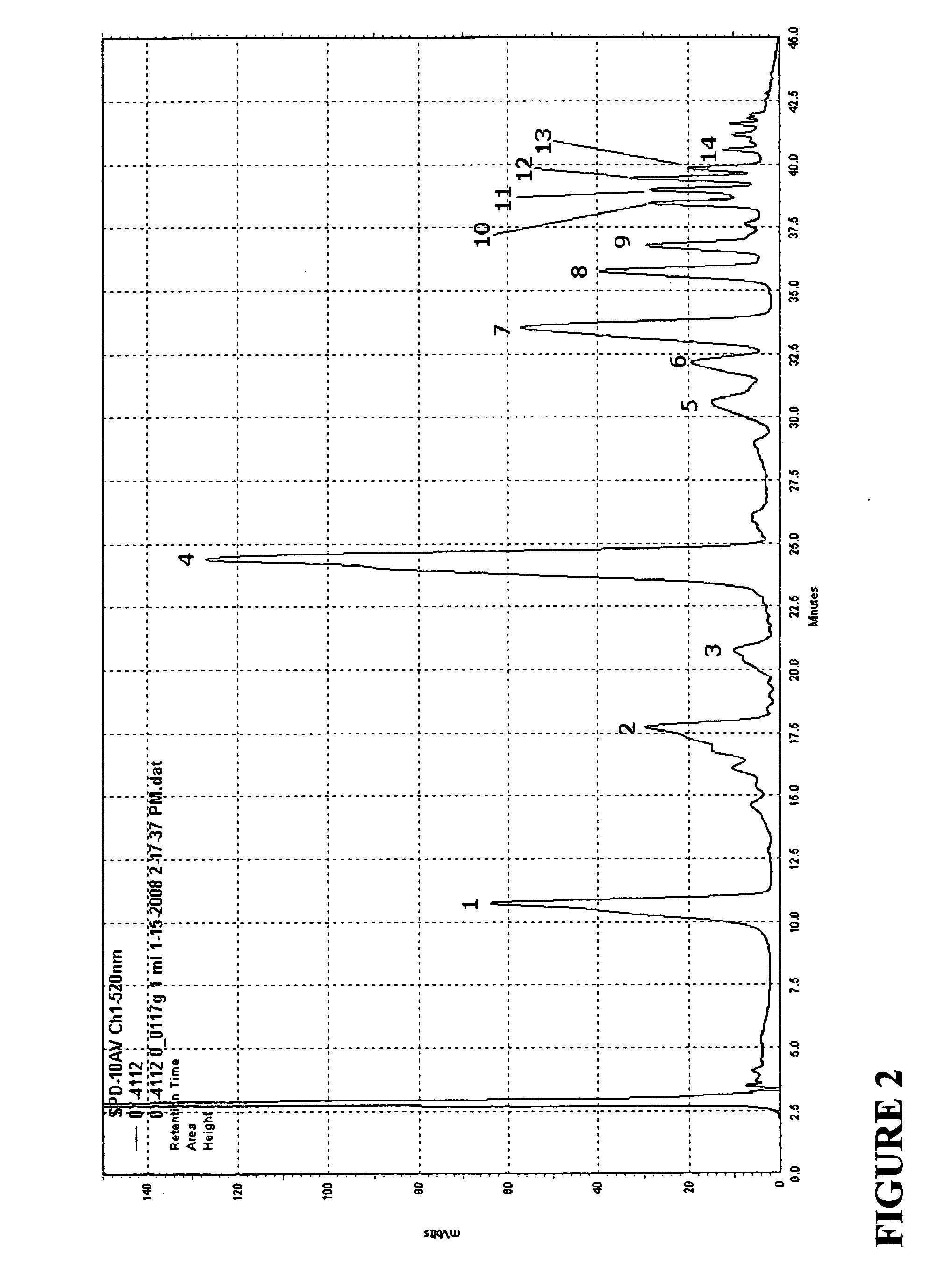Anthocyanin pigment/dye compositions through corn extraction
anthocyanin pigment and composition technology, applied in the field of natural occurring colorants and chemicals from plants, can solve the problems of univariate performance, unfavorable growth of hybrid plants, and inability to meet the needs of use, so as to reduce the stress on other ingredients, reduce color level, and improve the effect of us
- Summary
- Abstract
- Description
- Claims
- Application Information
AI Technical Summary
Benefits of technology
Problems solved by technology
Method used
Image
Examples
working example 1
[0172]One acre of the hybrid of FAR045*FAR601 was grown near Lamberton, Minn. in 2006. The seed / kernel yield, adjusted to 15.5% moisture at harvest and expressed at 56 pounds per bushel, was 120 bushels per acre.
working example 2
[0173]Referring to Table III, the hybrid of FAR045*FAR601 was grown in 2005 and 2006. Tissues from representative plants were sampled to determine anthocyanin concentrations extracted from each tissue. The plants were harvested near the black layer stage of maturity (late silage stage) on Sep. 30 in 2005 and Oct. 1 in 2006. In each year, samples from the tissues termed seed / kernel, husks, cobs, leaves, and stalks were taken, chopped by hand and air dried at about 50□C. The samples were then ground in a Waring Blender followed by a Retsch Mill. The ground samples were subsequently immersed in an extraction solution or solvent (50:50 water: alcohol (although not preferred), by volume having 0.1M HCl and stirred or agitated at about 37□C. After about 1.5 hours of agitation in the extraction solution, the resulting slurry was filtered through a nylon mesh screen, then through a #4 Whatman filter paper and assayed for proportion of anthocyanins present. In 2006 a greater amount and perce...
examples
Pigment Extraction by Whole Kernal Infusion Method
[0195]The following working example shows a whole kernel extraction process that removes 50% of total anthocyanins in the kernel without crushing or pulverizing of the kernel during or before the process. This is a significant technical and commercial benefit to the technology. The corn kernel by-product is fundamentally useful and marketable as a corn kernel for both human and agricultural animal consumption, and useful for almost all other commercial and manufacturing processes. The nutritional value, fiber value, lignin content and most other structural and chemical values of the corn kernels has been minimally altered. Additionally, because the pigment has been extracted from essentially whole kernel infused in water, the pigment product is classified differently by the FDA, and could be considered Generally Regarded as Safe (GRAS) for subsequent use in human consumables, cosmetics, pharmaceuticals and the like.
[0196]Laboratory S...
PUM
| Property | Measurement | Unit |
|---|---|---|
| Fraction | aaaaa | aaaaa |
| Percent by mass | aaaaa | aaaaa |
| Percent by mass | aaaaa | aaaaa |
Abstract
Description
Claims
Application Information
 Login to View More
Login to View More - R&D
- Intellectual Property
- Life Sciences
- Materials
- Tech Scout
- Unparalleled Data Quality
- Higher Quality Content
- 60% Fewer Hallucinations
Browse by: Latest US Patents, China's latest patents, Technical Efficacy Thesaurus, Application Domain, Technology Topic, Popular Technical Reports.
© 2025 PatSnap. All rights reserved.Legal|Privacy policy|Modern Slavery Act Transparency Statement|Sitemap|About US| Contact US: help@patsnap.com



